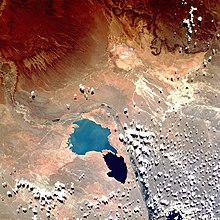Macrogryphosaurus
| Macrogryphosaurus | |
|---|---|

| |
| Scientific classification | |
| Domain: | Eukaryota |
| Kingdom: | Animalia |
| Phylum: | Chordata |
| Clade: | Dinosauria |
| Clade: | †Ornithischia |
| Clade: | †Neornithischia |
| Clade: | †Ornithopoda |
| Clade: | †Elasmaria |
| Genus: | †Macrogryphosaurus Calvo et al. 2007 |
| Species: | †M. gondwanicus
|
| Binomial name | |
| †Macrogryphosaurus gondwanicus Calvo et al. 2007
| |
Macrogryphosaurus (meaning "big enigmatic lizard") is a
Discovery and naming

In May 1999, during field work at
The species would be described and named Macrogryphosaurus gondwanicus in 2007, in a study authored by Jorge O. Calvo, Juan D. Porfiri, and Fernando E. Novas. Its generic name was derived from the Greek macro, meaning large, grypho, meaning enigmatic, and saurus, meaning lizard. The specific epithet gondwanicus refers to the ancient continent of Gondwana.[1] The holotype specimen, MUCPv-32, consists of an essentially complete set of vertebra, a number of ribs, four mineralized thoracic plates, both sides of the pectoral girdle, and a sternum. The individual is considered to have been an adult.[1][3] The preservation of the fossil was described by Dr. Stephen F. Poropat as "amazing" in nature.[2]
Subsequent research has not referred any other specimens to the species.[3] However, in 2016, a study was published on MAU-Pv-PH-458, a fragmentary dorsal neural arch from the Plottier Formation of northern Argentina. The bone is the northernmost record of an ornithopod in South America. It was not determined to belong to a Macrogryphosaurus, but noted to be from an animal of similar size and anatomy, and from approximately the same geographic and stratigraphic location, though it lived at a slightly earlier time.[4] Other indeterminate ornithopod specimens from Argentina similarly indicate animals of similar size to the taxon.[5][6] M. gondwanicus received a complete osteology in 2020, a study published in Cretaceous Research by Sebastián Rozadilla, Penélope Cruzado-Caballero, Jorge O. Calvo. This described the anatomy of the species in much more thoroughly and investigating its classification and biomechanics under a more modern lens. They considered the genus to be of importance, due to being the largest known elasmarian species, and for the completeness of its known remains, informing on the anatomy of the group.[3]
Description

Macrogryphosaurus has been noted for its large size compared to other South American ornithopods. It has been estimated to have been around 6 metres (20 ft) in length, though the only known individual may not have been fully grown.
Classification
Phylogenetic analysis indicates that it is related to Talenkauen, and Calvo and colleagues proposed a new clade, Elasmaria, for the two genera.[1]
The cladogram below results from analysis by Herne et al., 2019.[8]
| Ornithischia |
| ||||||||||||||||||||||||||||||||||||||||||||||||||||||||||||||||||||||||||||||||||||||||||||||||||||||
References
- ^ a b c d e Calvo, Jorge O.; Porfiri, Juan D.; Novas, Fernando E. (2007). "Discovery of a new ornithopod dinosaur from the Portezuelo formation (Upper Cretaceous), Neuquen, Patagonia, Argentina". Arquivos do Museu Nacional, Rio de Janeiro. 65 (4): 471–483.
- ^ a b Poropat, S. F. The Winston Churchill Memorial Trust of Australia.
- ^ S2CID 213679041.
- .
- S2CID 53407321.
- hdl:11336/71315.
- OCLC 985402380.
- .
External links
 Data related to Macrogryphosaurus at Wikispecies
Data related to Macrogryphosaurus at Wikispecies Media related to Macrogryphosaurus at Wikimedia Commons
Media related to Macrogryphosaurus at Wikimedia Commons
